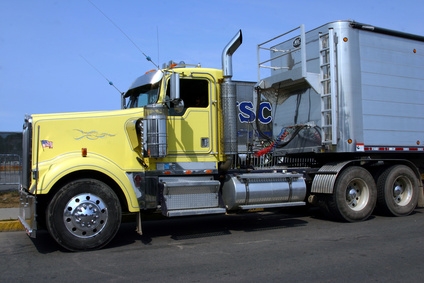
Federal regulations mandate that a truck driver reviews various vehicle components each time he heads out on the road using a checklist called the pretrip inspection. The Department of Transportation in each state may stop a truck at any time, checking driver logs and inspecting the tractor and trailer. Potential problems can be found during the pretrip inspection, possibly preventing dangerous situations on the road and avoiding fines. Failure to perform the pretrip inspection can result in reduced safety, breakdowns, fines and possibly even being parked by a DOT officer until all necessary repairs are made.
Before starting the engine, open the hood and check all the fluid levels, including oil, engine coolant, water, power steering fluid and windshield wiper fluid. The pretrip inspection also calls for examining all wires, belts and hoses for loose mounts, fraying, cracking or any other damage. Check the ground for any drips or puddles that may indicate a leak or potential problem.
As part of the pretrip inspection checklist, ensure all gauges, including the oil pressure and temperature gauges, are reading properly with no warning lights. Check the proper functionality of the clutch, gearshift, windshield wipers, turn signals and emergency flashers while sitting in the driver's seat. In addition, the cab should contain spare fuses, at least three emergency triangles and a functioning fire extinguisher.
Check your braking system from both inside and outside of the cab when following the pretrip inspection guidelines. From the cab, check the parking brakes, hydraulic brakes and air brakes by looking for any warning lights that may appear during testing. Walk around the exterior of the truck looking for any indicators of brake problems such as cracks, dents or holes in any of the braking system components. Problem indicators include broken or missing parts on the slack adjusters and leaks, cracking, dents and excessive wear of the brake hoses, drums, rotors and pads.
The wheels, on both the tractor and on the trailer, require special attention during the pretrip inspection. Ensure all tires are free of damage, have proper tread depth and are properly inflated. Other items to look for include damaged or bent rims, hub and axle seal leaks, and missing, cracked or loose lug nuts.
Often the most easily recognizable components checked as part of the pretrip inspection include those located on the exterior of the truck. Perform a complete review of the truck's exterior, looking for anything in need of repair such as the headlights, taillights, bumper, windshield, air shield and mirrors. Other items in need of inspection include, but are not limited to, the door handles, fuel tanks, muffler, battery box, drive shaft, exhaust system, doors and the steering linkage. Also check all couplings such as the fifth wheel, safety chains, tow bar and any locking device.
As a means of ensuring the safety of everyone on the road, perform a few additional steps if you are hauling hazardous materials. Federal regulations mandate the use of HAZMAT placards when hauling hazardous materials. The placard must indicate the type of material being hauled and be placed securely on the load. Keep all paperwork pertaining to the load close at hand since DOT officers may request access to it at any time.